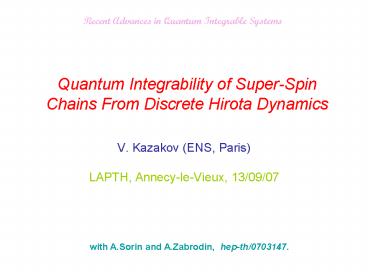Quantum Integrability of SuperSpin Chains From Discrete Hirota Dynamics PowerPoint PPT Presentation
1 / 28
Title: Quantum Integrability of SuperSpin Chains From Discrete Hirota Dynamics
1
Quantum Integrability of Super-Spin Chains From
Discrete Hirota Dynamics
Recent Advances in Quantum Integrable Systems
- V. Kazakov (ENS, Paris)
- LAPTH, Annecy-le-Vieux, 13/09/07
with A.Sorin and A.Zabrodin, hep-th/0703147.
2
Motivation
- Classical and quantum integrability are
intimately related (not only through the
classical limit!) - Quantization discretization
- Quantum spin chain Discrete classical
Hirota dynamics - We study SUSY spin chain via Hirota equation for
fusion rules, with specific integrable boundary
conditions. - More general and more transparent with SUSY!
- An alternative to algebraic Bethe ansatz
Klumper,Pearce 92, Kuniba,Nakanishi,92
Krichever,Lupan,Wiegmann, Zabrodin97
Kulish,Sklianin80-85
3
Plan
R-matrix and Yang-Baxter eq. for SUSY spin chain
Bazhanov-Reshetikhin rel. Hirota eq. for fusion
Bazhanov,Reshetikhin90
SUSY boundary cond., Bäcklund transf.
undressing
Baxter TQ relations Hirota eq for Q-functions
(QQ relations)
Analyticity and SUSY nested Bethe ansatz Fusion
in quantum space examples, gl(11), gl(21)
4
sl(KM) super R-matrix
Vector irrep v in aux. space and arbitrary l
in quantum
For lv graded permutation
for even (odd) components
5
Yang-Baxter relation for R-matrix
ß''
ß''
u
ß'
a
ß'
?
?'
u
a
?''
?''
?'
ß
ß
?
v
a'
v
a'
a''
a''
0
0
6
Monodromy Matrix and Transfer Matrix
ß2
ß1
ßN
u
l, ai
l
l
T ßi
u1
u2
uN
a2
? quantum space ?
a1
aN
auxiliary space
- Transfer matrix supertrace of monodromy
matrix, in irrep l
polynomial of degree N
- Defines all conserved charges of
(inhomogeneous) - super spin chain.
How to calculate it?
7
T-matrix Eigenvalues as Quantum Characters
- Conservation laws
- Bazhanov-Reshetikhin determinant formula
- Expresses
for general irrep ?
through
for the row
s
8
Hirota relation for rectangular tableaux
a
T(a,s,u) ?
s
- From BR formula, by Jakobi relation for det
T(u)
T (u)
T(u)
T (u1)T(u-1)
a
T (u)
representation plane (a,s)
s
9
Hirota relation
- Direct consequence of Bazhanov-Reshetikhin
quantum - character formula.
- Hirota eq. integrable, Master equation of the
soliton theory. - The classical inverse scattering method can be
applied. - Boundary conditions specific to the model
(R-matrix). - Analyticity T-functions become polynomials
- of the same power NLength of spin chain,
- We use Hirota eq. to find all possible Baxters
TQ relations and nested Bethe ansatz equations
for superalgebras.
10
SUSY Boundary Conditions Fat Hook
a
K
T(a,s,u)?0
s
M
- All super Young tableaux of sl(KM) live within
this fat hook
11
Bäcklund Transformation I (BT-I)
T(u1)
F(u)
T(u)
F(u)
F(u1)
T(u1)
? First Lax pair of linear problems for ,
equiv. to Hirota eq. ?
a
F(u)
s
T(u1)
T(u)
T(u1)
F(u)
F(u1)
F(u)
On the horizontal boundary one can put
F(K,s,u)0.
12
Undressing by BT-I vertical move
a
K
K-1
s
M
T(a,s,u) TK,M (a,s,u) ? F(a,s,u)
TK-1,M(a,s,u)
Notation
sl(KM) sl(K-1M)
n
TK-1,M(a,s,u) also satisfies Hirota eq., but
with shifted B.C.
13
Bäcklund Transformation - II
T(u)
F(u)
F(u1)
T(u)
T(u1)
F(u1)
? Second Lax pair of linear problems ?
a
s
F(u1)
F(u)
F(u1)
T(u)
T(u1)
T(u)
14
Undressing by BT-II horizontal move
a
K
s
M
M-1
TK,M (a,s,u) ? F(a,s,u) TK,M-1 (a,s,u)
.?Tk,m (a,s,u)
sl(KM) sl(K-1M) sl(km)
0
n
General Nesting
n
n
- One can repeat this procedure until the full
undressing K,M0 T0,0(u)1.
15
Boundary conditions..
a
Tsuboi97
Qk,0(uam)Q0,m(u-a-m)(-1)m(a-k)
Qk,m(ua)
Qk,0(usk) Q0,m(u-s-k)
k
Tk,m (a,s,u)? 0
s
m
Qk,m(u-s)
- B.C. respect Hirota equation.
Qk,m(u)?j (u-uj )
- B.C. defined through Baxters Q-functions
k1,,K m1,M
16
Undressing along a zigzag path (Kac-Dynkin
diagram)
undressing (nesting) plane (k,m)
k
(K,0)
9
(K,M)
At each (k,m)-vertex there is a Qk,m(u)
8
6
7
3
4
5
particle-hole duality
Tsuboi98
2
m
0
(0,M)
1
Analyticity
- By construction T(u,a,s) TK,M(u,a,s),
- Qk,m (u) and Tk,m(u,a,s) are polynomials
in u.
17
Strategy
- Express T-functions through Q-functions.
- Find Q-functions from analyticity
(polynomiality). - This gives Nested Bethe Ansatz
18
Generalized Baxters T-Q Relations
- Diff. operator encoding all Ts for symmetric
irreps
- From Hirota eq.
where
are shift operators on (k,m) plane.
19
Generalized Baxters T-Q Relations
k
(K,0)
9
(K,M)
n1
8
x
n2
6
7
4
5
3
2
m
0
1
(0,M)
V.K.,Sorin,Zabrodin07
- coordinate on (k,m) plane
- unit vector in the direction of shift
20
Hirota eq. for Baxters Q-functions
(Q-Q relations)
k1,m
k1,m1
Zero curvature cond. for shift operators
k,m
k,m1
V.K.,Sorin,Zabrodin07
Q (u2)
Q (u)
Q (u2)
k
Q (u)
Q (u)
Q (u2)
m
21
Bethe Ansatz Equations along a zigzag path
- BAEs follow from zeroes of various terms in
Hirota QQ relation
and Cartan matrix along the zigzag path
1, if
where
-1, if
22
Higher irreps and fusion in quantum space
V.K.,Sorin,Zabrodin07
quantum
M-m
M
l'km
K-k
µkm
µKM
K
lkm
auxiliary
arbitrary polynomial
A relevant subsequent work
Ragoucy, Satta07
23
gl(11) algebra
a
a-1
Q1,0(ua1)Q0,1(u-a-1) (-1)
Q1,1(ua)
Q1,0(us1) Q0,1(u-s-1)
s
Q1,1(u-s)
- We reproduce BAEs and Baxters TQ relations,
including - the typical irreps with continuous labels, in
accordance with
Fendley,Intriligator92
24
sl(21) algebra
a
Q2,0(ua1)Q0,1(u-a-1) (-1)a-2
Q2,1(ua)
Q2,0(us2) Q0,1(u-s-2)
T2,1 (1,s,u)
s
Q2,1(u-s)
- We reproduce BAEs and Baxters TQ relations,
including - the irreps with continuous labels, in
accordance with
- Frahm,Pfanmüller96
- .
- Bazhanov,Tsuboi07
- Related to Beiserts su(22) S-matrix.
25
Example Baxter and Bethe equations for sl(21)
with Kac-Dynkin diagram
Generating functional for antisymmetric irreps
T-matrix eigenvalue in fundamental irrep
Bethe ansatz equations
26
Applications and Problems
- Generalizations noncompact irreps, mixed
(covariantcontravariant) irreps, so(MK),
sp(MK) algebras. - Non-standard R-matrices, like Hubbard or
- su(22) S-matrix in AdS/CFT, should be also
- described by Hirota equation with different
B.C. - A powerful tool for constructing and studying
supersymmetric spin chains and 2d integrable
field theories, including classical limits. - An alternative to the algebraic Bethe
ansatz.
27
k
K
(K,M)
m
(0,0)
M
28
s
µ(a,s)
a
µ\µ(a,s)

